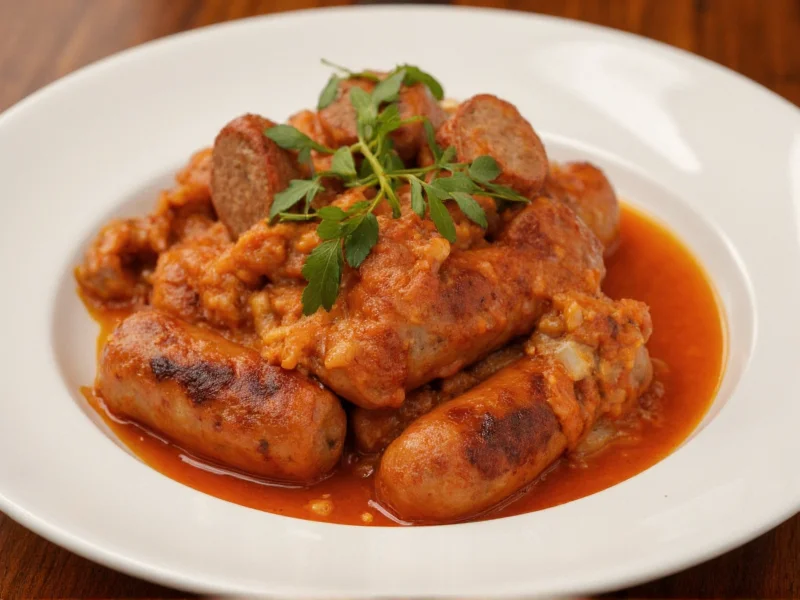Creating the perfect sausage meat casserole requires understanding the balance between quality ingredients and proper cooking technique. This beloved British comfort food has evolved from humble farmhouse origins to a sophisticated centerpiece for family dinners. Unlike quick weeknight meals, a proper sausage casserole benefits from slow cooking that allows flavors to meld while keeping the sausages intact and juicy.
Essential Ingredients for Authentic Sausage Meat Casserole
The foundation of an exceptional sausage meat casserole starts with ingredient selection. While regional variations exist across the UK, certain elements remain consistent in traditional preparations. Choosing the right sausages makes the most significant difference—look for British pork sausages with at least 70% meat content and natural casings. Avoid pre-cooked or skinless varieties, as they won't hold up during the slow cooking process.
| Ingredient | Traditional Amount | Quality Considerations |
|---|---|---|
| Pork sausages | 1kg (2.2 lbs) | Look for 70%+ meat content with natural casings |
| Onions | 2 large, chopped | Yellow onions provide best flavor balance |
| Carrots | 3 medium, sliced | Fresh, firm carrots maintain texture |
| Tomato passata | 500ml (2 cups) | Higher quality passata yields richer flavor |
| Red wine | 150ml (⅔ cup) | Dry variety like Cabernet Sauvignon works best |
| Thick-cut bacon | 150g (5 oz) | Smoked variety adds depth of flavor |
Step-by-Step Cooking Method
Mastering the technique for sausage meat casserole separates adequate versions from truly exceptional ones. The critical step many home cooks miss is properly browning the sausages before adding liquid. This Maillard reaction creates complex flavor compounds that can't be replicated through simmering alone.
Begin by heating olive oil in a heavy-bottomed casserole dish over medium-high heat. Brown the sausages in batches without overcrowding—this ensures proper searing rather than steaming. Remove when golden on all sides but not fully cooked through. Next, render the bacon until crisp, then sauté onions and carrots until softened but not caramelized. Deglaze the pan with red wine, scraping up all the flavorful browned bits from the bottom.
Return the sausages to the dish along with tomato passata, thyme sprigs, and a bay leaf. The liquid should come halfway up the sausages—not covering them completely. This partial submersion allows the sausages to cook through while maintaining their shape. Cover and transfer to a preheated oven at 160°C (325°F) for 60-75 minutes until the sausages are cooked through and the sauce has thickened.
Perfecting Your Sausage Casserole: Pro Tips
Professional chefs achieve restaurant-quality sausage meat casserole through several subtle techniques worth incorporating. First, select sausages with natural casings rather than collagen—they hold their shape better during slow cooking. Second, don't skip the wine deglazing step; the fond (browned bits) contains concentrated flavor essential to depth.
For the best texture, avoid boiling the casserole—gentle oven simmering prevents the sausages from splitting. If your sauce seems too thin after cooking, remove the sausages and reduce it on the stovetop before returning them. Adding a teaspoon of Worcestershire sauce near the end enhances umami without making the dish taste overtly 'Worcestershire.'
Variations Across the British Isles
Regional sausage meat casserole variations reflect local ingredients and traditions. In Yorkshire, cooks often add a spoonful of HP sauce and serve with Yorkshire pudding. Scottish versions sometimes incorporate a splash of whisky and neeps (mashed turnips). Welsh adaptations might include laverbread or cockles for coastal variations.
For a lighter version, try substituting chicken sausages and using vegetable broth instead of red wine. Vegetarian adaptations work surprisingly well with high-quality plant-based sausages and mushroom broth, though purists might argue this strays from the traditional sausage meat casserole concept.
Serving and Storage Recommendations
Serve sausage meat casserole hot, ideally with creamy mashed potatoes or buttery Yorkshire puddings to soak up the rich sauce. A side of steamed green vegetables like kale or Brussels sprouts provides color contrast and balances the meal. Leftovers actually improve overnight as flavors continue to meld—store in an airtight container in the refrigerator for up to three days.
When reheating, do so gently over low heat to prevent the sausages from becoming tough. Freezing works well for this dish; portion into freezer-safe containers with sauce completely covering the sausages to prevent freezer burn. Thaw overnight in the refrigerator before reheating.
Troubleshooting Common Issues
Several issues commonly arise when preparing sausage meat casserole. If sausages split during cooking, the oil was likely too hot during initial browning. For a sauce that's too thin, remove sausages and simmer uncovered until reduced. If the dish tastes overly acidic, balance with a pinch of sugar or a small amount of cream.
When sausages become tough, it usually indicates overcooking—remove them when nearly done and let residual heat finish the process. For lack of depth, consider adding a small piece of Parmesan rind during cooking (remove before serving) or a dash of fish sauce for umami enhancement.











 浙公网安备
33010002000092号
浙公网安备
33010002000092号 浙B2-20120091-4
浙B2-20120091-4